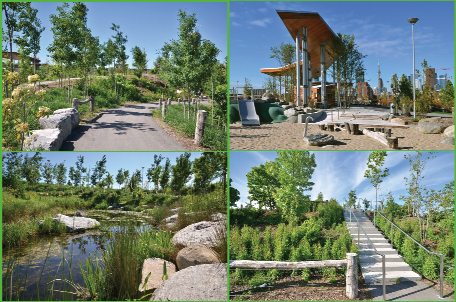Summertime, soon slowly fading, makes us more aware of our relationship to nature. As city dwellers in our fixed man-made surroundings of hard buildings and streets, we treasure the soft, living and changing forms of nature.
Our minds and perceptions are invigorated by trees, bushes, flowers and greenery. They grow and change like we do. We feel part of them, part of an incredibly beautiful, intricate and varied nature.
Studies indicate green spaces produce positive human health effects. They help reduce high blood pressure and stress. Elderly and youth benefit more than other groups. Parks encourage physical activity from leisurely walking to vigourous games. Removed from the hurly-burly of traffic, parks also provide a serene, contemplative setting.
Downtown Toronto is deficient in green spaces. Suitable Downtown park land is scarce and too expensive and cumbersome to buy through our city’s varied parks levy for new residential developments. A few small, city-initiated Downtown green improvements, however, should be noted.
The small city-owned parking lot immediately south of St. Lawrence Market will eventually become an extension of the attractive and well-used David Crombie Park along The Esplanade. Meanwhile, the lot will temporarily house present North Market functions in a demountable structure while the present North Market is replaced by the new building just approved by city council. Be patient.

A modest Gardiner Expressway change in centre Downtown is today also ready for implementation when funding becomes available, if ever, under the Ford administration’s tax-cut mania. The long eastward ramp to York St., Bay and Yonge will be shortened and directly end on a 4-lane eastbound Harbour St. at Lower Simcoe.
The wide, elevated loop above the small park at York St. will mercifully disappear. A proposed new north-south street through the eastern part of this park was vetoed by city council last year. The park will be liberated from cars and returned to people in the Downtown asphalt jungle among the high-rises—a small but significant green victory by our city.
Only the appearance 12 years ago of the tri-government-funded Waterfront Toronto organization (WT) has made possible the addition of truly significant Downtown green spaces on former industrial land that’s now publicly owned. The first is the very fine, urban Sherbourne Common and popular Sugar Beach facing the lake. The second is the just-opened, heavily landscaped and varied Corktown Common in the developing West Don Lands next to the Don River, site of the Athletes Village of the 2015 Pan-American Games.
WT is also in the complex and messy process of constructing a lovely, treed central waterfront Queen’s Quay accommodating private and public transport, a bike path and a wide pedestrian promenade with undulating wavedecks.
An active non-profit organization called 8-80 Cities concentrates on making cities healthy and livable for people of all ages; hence its name. Some of its ideas were inspired by a visionary Danish architect, Jan Gehl, now an international urban quality consultant. 8-80 Cities has spread its activities across the world with its headquarters right here in Toronto led by an eloquent Gil Penalosa (see www.8-80cities.org).
With a grant from the Healthy Communities Fund of the Ontario Ministry of Health, 8-80 Cities has studied Berczy Park on Front St. behind the iconic Gooderham Flatiron building. (See their lavishly illustrated report at www.8-80cities.org/images/tools-community-reports-articles/berczy-park-report.pdf).
Local residents and businesses are already trying to make Berczy Park more useable for all people—women, old adults, youth and children—and dogs. 8-80 Cities has also studied St. James Park by the imposing Anglican cathedral on King St. and is preparing a report on it.
Centretown residents are blessed with proximity to the luscious Toronto Islands protecting our harbour. While the islands are free of noisy and polluting cars, its increasingly busy commercial airport threatens the tranquility, air quality and perhaps even safety of our waterfront. This will get worse if jets are allowed as now sought by aggressive Porter Air.
Did the federally controlled Toronto Port Authority rename its island airport the Billy Bishop Airport to hide its location? The airport occupies one-quarter of the entire Toronto Islands.
 TheBulletin.ca Journal of Downtown Toronto
TheBulletin.ca Journal of Downtown Toronto

